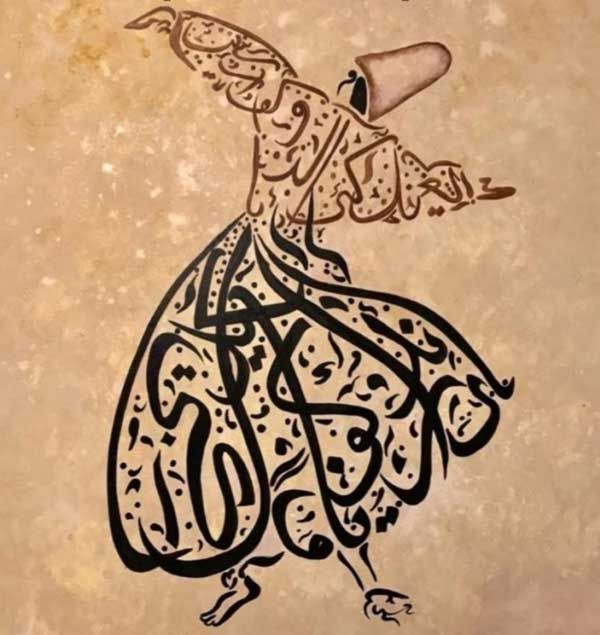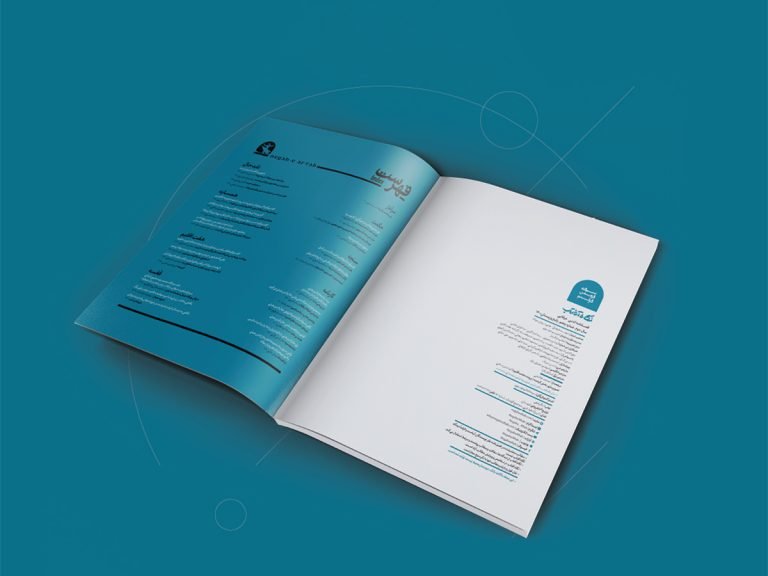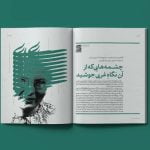This issue of Negah-e Aftab quarterly has a special interview with Professor Gholam Hossein Amirkhani, in which this eminent artist expresses his views on mysticism and Rumi and the relations of the Iranian Calligraphy with those concepts.
Negah-e Aftab; Literary and Mystic Quarterly
Issue 2, Volume 1, Autumn 2021
- Publisher: Soroosh-e Mowlana Institute for Arts and Culture
- Director-in-Charge: Maryam Mousavi
- Editorial Board: Seyed Hedayat Jalili, Amir Yousefi, Pejman Mousavi
- Editorial Collaborators: Azime Sattari, Hajarkhatoon Ghadami Juybari, Ehsan Ebrahimi and Behnam Naseri
- Special Thanks to: Seyed Amir Akrami, Mohammad Mahid Mojahedi, Ardeshir Mansouri, Ebrahim Mouapour Besheli, Davoud Vafaei, Mahmoud Moghaddasi, Seyed Hasan Eslami Ardakani, Mojtaba Sabzeh and Ali Jazayeri
- Graphic Designer: MASHGH Studio
- Art Director and Graphic Designer: Hamed Hakimi
- Calligraphy on Cover and Poster: Master Gholam Hossein Amirkhani
- Layout Designer: Arash Roshangar
In this issue we read:
- The “Wisdom” section of this issue addresses the important topic of human loneliness as a human and global concern from various dimensions, and also Rumi’s teachings on loneliness is studied in details. Mustafa Malekian, Amir Abbas Ali Zamani, Taghi Azad Armaki, Seyed Ahmad Jalali, Gholam Hossein Motamedi, Mahdieh Kasaei Zadeh, Seyed Majid Gharavi, Bagher Talebi Darabi, Mehdi Minakhani, Mohammad Ghanbari, Kimia Hadizadeh and Mahmoud Dehghani are the authors of the second issue of Nehah-e Aftab quarterly.
- The “Performance” section of this issue of Negah-e Aftab quarterly is dedicated to Reynold Nicholson, one of the major Rumi researchers of the world and his works and scientific life is analyzed. In this section, Mohammad Jafari Dehaghi, Abdollah Anwar, Bahaeddin Khorramshahi, Nasrollah Pourjavadi, Homayoun Hemmati, Jamshid Kianfar, Ali Ashraf Sadeghi, Reza Ashrafzadeh present their ideas and views on Nicholson.
- In the “Research” section, Mahnaz Ghanei, Amir Akrami, Mohammad Navid Bazargan, Iraj Rezaei, Nasrin Faqih Malek Marzban and Ebrahim Khodayar answer the question that which correction, explanation and monograph of Rumi’s thoughts and worldviews they prefer the most.
- The “Arts” section in each issue of Negah-e Aftab quarterly examines the position and influence of Rumi in the Iranian arts. In this issue, one of the most important sphere of Rumi’s influence particularly in the last century is analyzed. In this section Alireza Mir Alinaghi, Kiekhosro Pournazeri, houshang Javid and Behzad Abdi talk about Rumi’s relationship with Iranian classical music. Furthermore, on the occasion of the death of Mohammad Reza Shajarian and to honor this eminent figure, a special tribute is paid to his works as one of the major singers of the mystical literature in Iran and his selection of Rumi’s poems. Moreover, Majdeddin Keivani, Shahroukh Tuyserkani, Seyed Abolhasan Mokhtabad and Noureddin Mirfakhraei write about pieces about him.
- In the “Critique” section of this issue, which reflects dissenting voices and critical views of Rumi’s mystical heritage and teachings, Ardeshir Mansouri talks about mysticism and religion as a prelude to the discussion about the relationship between mystical teachings and the contemporary human needs. Mohammad Javad Gholamreza Kashi addresses the unbridgeable gap between mysticism and the modern world. In his article, Shahram Sahraei explains the Mystics of Najaf order and their views on Rumi. Moreover, this section contains interviews with Mohammad Ali Homayoun Katouzian about the characteristics of a good life and ethics according to Saadi Shirazi, and with Mehdi Nasiri about the heritage of Sufism and mysticism.
- The “Neighbor” section in this issue examines Rumi’s position in the academic and social environment of Afghanistan, which contains articles written by Seyed Jamaleddin Mousavi, Seyed Es’hagh Shojaei, Naghshband Heidari, Seyed Hasan Akhlagh and Javid Mojaddadi.
- In the “Lived Experiences” section, Hadi Khaniki, Abdol Jabbar Kakaei, Mohammad Tolouei and Abdoljavad Mousavi talk about their personal encounters with the lifeworld of Rumi.
- “Death from Rumi’s Perspective” by William Chittik, “Rumi’s Social History: A New Proposal” by Ebrahim Mousapour and “Time, the Birthplace of Illusion” by Hasan Faramarzi are the titles of the articles in this issue of Negah-e Aftab quarterly.
- In the “Shelf” section of this issue, which contains some reviews of the latest publications in mysticism and Rumi’s studies and research, four books are presented. Hossein Mokhtari writes an analytical review of the fourth edition of “A Magnum of divine wine” written by Professor Mohammad Ali Movahed; Alireza Rezayat introduces an English book entitled “Rumi and Shams’ silent rebellion”; Davoud Vafaei introduces a Turkish book entitled “Sufism and the orders in the Ottoman Empire” written by Mustafa Kara. Furthermore, an interview is held with Maryam Jafari, the author of the book “Art, Imagination and beauty” for the publication of this book.
- In the “Account” section, the overview of the most important news and events in Rumi studies and Rumi research is published.
- As usual for each issue of the quarterly, the translation of the summary of the content is provided in the languages of English, Turkish and Arabic.
The concessionaire of Negah-e Aftab quarterly is Soroosh-e Mowlana Institute for Arts and Culture and its managing director is Ms. Maryam Mousavi.
For more information and buy the quarterly, visit Negah-e Aftab website at: http://negaheaftab.com
https://www.negaheaftab.com/order
or contact us on:
Phone: +989196721586
Instagram:
http://instagram.com/negaheaftab
Telegram:










